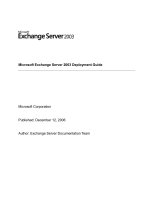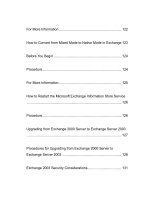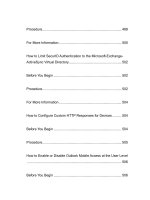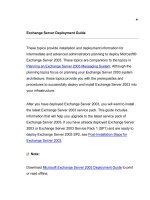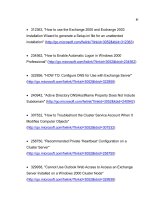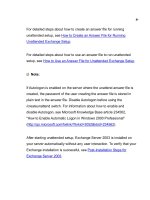Microsoft Exchange Server 2003 Deployment Guide- P7 doc
Bạn đang xem bản rút gọn của tài liệu. Xem và tải ngay bản đầy đủ của tài liệu tại đây (161.45 KB, 10 trang )
61
Security Enhancement for Outlook Web Access
To prevent unsafe code from being executed within the browser for
certain MIME types, Exchange Setup adds new file extensions to the
Outlook Web Access block lists. This update provides a list of known
content types that are allowed to start within the browser.
Installing New Exchange 2003 Servers
This topic provides information about deploying new installations of
Microsoft® Exchange Server 2003 in your organization. Specifically, this
topic will:
Provide you with the requirements necessary to install
Exchange 2003.
Provide you with information about running Exchange Server 2003
Deployment Tools.
Provide you with information about front-end and back-end
architecture, including how to configure a front-end server.
Show you how to run ForestPrep.
62
Show you how to run DomainPrep.
Show you how to install Exchange Server 2003 on new servers,
including how to run Exchange Server 2003 Setup in attended and
unattended modes.
Note:
If you are migrating an Exchange Server 2003 server to a new
Exchange Server 2003 computer see Microsoft KB article 822945,
How to move Exchange 2003 to new hardware and keep the same
server name. Use the information provided in that article together with
the information in this topic to install a new Exchange Server 2003
server.
Permissions for Installing New Exchange Server 2003 Servers
After ensuring that your organization meets the necessary prerequisites,
the procedures referenced in this topic guide you through the deployment
process. This process includes installing the first Exchange Server 2003
computer into your organization.
Table 1 lists the required permissions or roles for the procedures
referenced in this topic.
63
Table 1 Procedures referenced in this topic and corresponding
permissions
Procedure Required permissions or roles
Enable Microsoft Windows®
2000 Server or Microsoft Windows
Server™ 2003 services
See Windows 2000 or Windows
Server 2003 Help
Run ForestPrep on a domain
controller (updates the Microsoft
Active Directory® directory service
schema)
Enterprise Administrator
Schema Administrator
Domain Administrator
Local Machine Administrator
Run DomainPrep
Domain Administrator
Local Machine Administrator
64
Procedure Required permissions or roles
Install Exchange Server 2003 on
the first server in a domain
Exchange Full Administrator role
applied at the organization level
Local Machine Administrator
Install Exchange Server 2003 on
additional servers in the domain
Exchange Full Administrator role
applied at the administrative group
level
Exchange Server 5.5 Site
Administrator (if installing into an
Exchange Server 5.5 site)
Local Machine Administrator
Install the first instance of a
connector
Exchange Full Administrator
applied at the organization level
65
For more information about managing and delegating permissions and
user and group authorities, see the Exchange Server 2003 Administration
Guide (
Exchange Server 2003 Security Considerations
Before installing Exchange Server 2003 in your organization, it is
important that you are familiar with your organization's security
requirements. Familiarizing yourself with these requirements helps ensure
that your Exchange Server 2003 deployment is as secure as possible.
For more information about planning Exchange Server 2003 security, see
the following guides:
Planning an Exchange Server 2003 Messaging System
(
Exchange Server 2003 Security Hardening Guide
(
Exchange Server Deployment Tools
Exchange Server Deployment Tools are tools and documentation that
lead you through the entire installation or upgrade process. To ensure
that all of the required tools and services are installed and running
66
properly, it is recommended that you run Exchange Server 2003 Setup
through the Exchange Server Deployment Tools.
Note:
You must download the latest version of the Exchange Server
Deployment Tools before you run them. To receive the latest version of
the tools, see the Downloads for Exchange Server 2003 Web site
(
For detailed steps about how to start the Exchange Server Deployment
Tools, see How to Start the Exchange Server Deployment Tools. After you
start the tools and specify that you want to follow the process for New
Exchange Server 2003 Installation, you are provided with a checklist
detailing the following installation steps:
Verify that your organization meets the specified requirements.
Install and enable the required Windows services.
Run the DCDiag tool.
Run the NetDiag tool.
67
Run ForestPrep.
Run DomainPrep.
Run Exchange Setup.
With the exception of running the DCDiag and NetDiag tools, each of
these installation steps is detailed later in this topic. For more information
about the DCDiag and NetDiag tools, refer to the Exchange Server
Deployment Tools. It is recommended that you run the DCDiag and
NetDiag tools on every server on which you plan to install Exchange
Server 2003.
When you use Exchange Server Deployment Tools, you can run specific
tools and utilities to verify that your organization is ready for the
Exchange Server 2003 installation. If you do not want to run Exchange
Server Deployment Tools, read the remaining sections in this topic for
information about manually installing Exchange Server 2003.
System-Wide Requirements for Exchange Server 2003
Before you install Exchange Server 2003, ensure that your network and
servers meet the following system-wide requirements:
68
Domain controllers are running Windows 2000 Server Service Pack 3
(SP3) or Windows Server 2003.
Global catalog servers are running Windows 2000 SP3 or Windows
Server 2003. It is recommended that you have a global catalog server in
every domain where you plan to install Exchange Server 2003.
Domain Name System (DNS) and Windows Internet Name Service
(WINS) are configured correctly in your Windows site.
Servers are running Windows 2000 SP3 or Windows Server 2003
Active Directory.
For more information about Windows 2000 Server, Windows
Server 2003, Active Directory, and Domain Name System (DNS), see the
following resources:
Windows 2000 Help
Windows Server 2003 Help
Best Practice Active Directory Design for Exchange 2000
Server(
69
Planning an Exchange Server 2003 Messaging System
(
Server-Specific Requirements for Exchange Server 2003
Before you install Exchange Server 2003, ensure that your servers meet
the requirements that are described in this section. If your servers do not
meet all the requirements, Exchange Server 2003 Setup will stop the
installation.
Hardware Requirements
The following are the minimum and recommended hardware
requirements for Exchange Server 2003 servers:
Intel Pentium or compatible 133 megahertz (MHz) or faster processor
256 megabytes (MB) of RAM recommended minimum, 128 MB
supported minimum
500 MB of available disk space on the drive on which you install
Exchange
70
200 MB of available disk space on the system drive
CD-ROM drive
SVGA or higher-resolution monitor
For more information about hardware requirements for front-end and
back-end servers, see the guide Exchange Server 2003 and Exchange
2000 Server Front-End and Back-End Server Topology Guide
(
File Format Requirements
To install Exchange Server 2003, disk partitions must be formatted for
NTFS file system and not for file allocation table (FAT). This requirement
applies to the following partitions:
System partition
Partition that stores Exchange binaries
Partitions containing transaction log files
